Marketing DissERTATION MARKETING DISSERTATION 20 20 Marketing Dissertation Name of the student Name of the university
Added on 2022-10-12
64 Pages15786 Words281 Views
Running head: MARKETING DISSERTATION
Marketing dissertation
Name of the student
Name of the university
Author note
Marketing dissertation
Name of the student
Name of the university
Author note
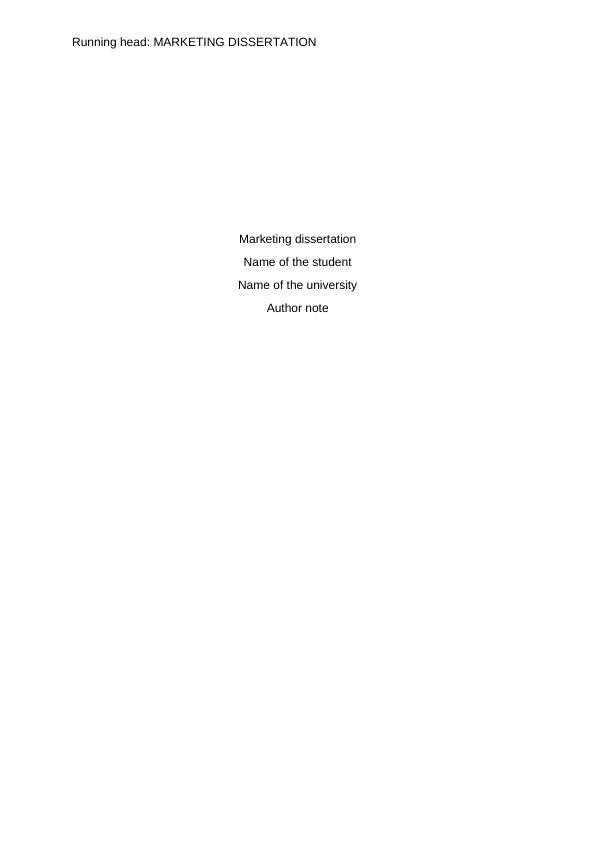
MARKETING DISSERTATION1
Abstract
The advancement of technology in the past few years due to globalisation had
resulted in the development of low-input seasonal crops. Denmark had experienced
the highest growth in the global market organic food industry, but the analysis of past
literary sources show a lack of literature on the attitude of Nepali consumers in
Denmark on organic food products. The study had identified that all the demographic
factors had been evaluated in past studies. There is a lack of data on the influence of
ethnicity on the attitude consumers towards organic food products. The research has
used a single research design where a survey has been used to perform statistical
analysis on gathered data. Positive results were obtained in the research where
ethnicity was found to have significant impact on the attitude of the consumers.
Abstract
The advancement of technology in the past few years due to globalisation had
resulted in the development of low-input seasonal crops. Denmark had experienced
the highest growth in the global market organic food industry, but the analysis of past
literary sources show a lack of literature on the attitude of Nepali consumers in
Denmark on organic food products. The study had identified that all the demographic
factors had been evaluated in past studies. There is a lack of data on the influence of
ethnicity on the attitude consumers towards organic food products. The research has
used a single research design where a survey has been used to perform statistical
analysis on gathered data. Positive results were obtained in the research where
ethnicity was found to have significant impact on the attitude of the consumers.
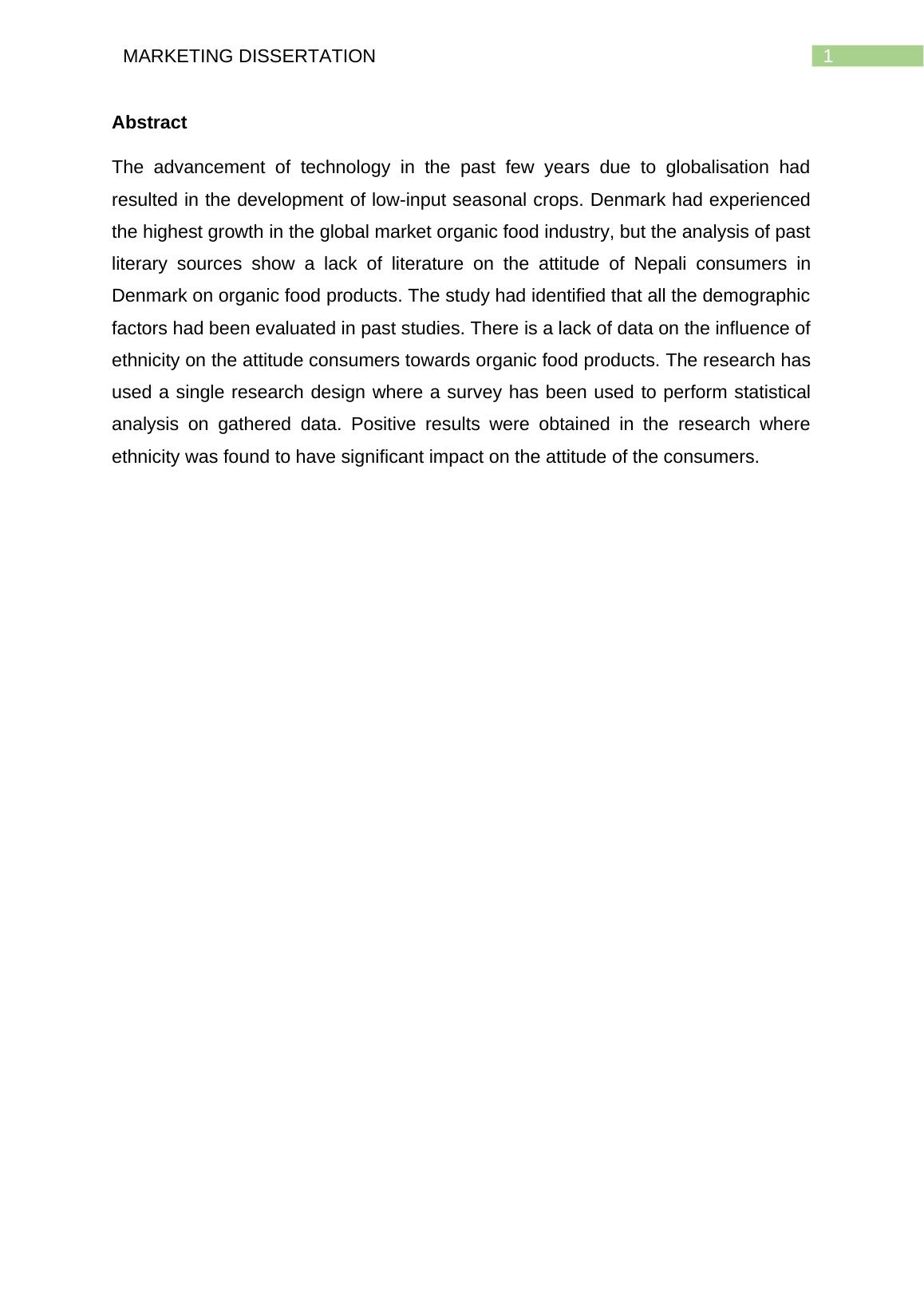
MARKETING DISSERTATION2
Table of Contents
Chapter 1: Introduction................................................................................................6
1.0 Introduction.........................................................................................................6
1.1 Background of the study.....................................................................................6
1.2 Research problem...............................................................................................9
1.3 Research objectives............................................................................................9
1.4 Research questions..........................................................................................10
1.5 Structure of the dissertation..............................................................................10
Chapter 2: A Literature review....................................................................................12
2.1 Introduction.......................................................................................................12
2.2 Consumer attitude and expectation of organic food products..........................12
2.3 Personal identities and consumer values.........................................................14
2.4 Demographic factors.........................................................................................16
2.5 Price..................................................................................................................18
2.7 Conceptual framework......................................................................................19
2.8 Research hypothesis........................................................................................19
2.8 Research gap....................................................................................................19
Chapter 3: Methodological discussion........................................................................20
3.1 Introduction.......................................................................................................20
3.2 Research philosophy........................................................................................20
3.3 Research approach...........................................................................................20
3.4 Research design...............................................................................................21
3.5 Data collection and analysis.............................................................................21
3.6 Sampling technique..........................................................................................22
3.7 Reliability and validity........................................................................................22
3.8 Ethical consideration.........................................................................................23
Chapter 4: Empirical data and research findings (2500)............................................24
Table of Contents
Chapter 1: Introduction................................................................................................6
1.0 Introduction.........................................................................................................6
1.1 Background of the study.....................................................................................6
1.2 Research problem...............................................................................................9
1.3 Research objectives............................................................................................9
1.4 Research questions..........................................................................................10
1.5 Structure of the dissertation..............................................................................10
Chapter 2: A Literature review....................................................................................12
2.1 Introduction.......................................................................................................12
2.2 Consumer attitude and expectation of organic food products..........................12
2.3 Personal identities and consumer values.........................................................14
2.4 Demographic factors.........................................................................................16
2.5 Price..................................................................................................................18
2.7 Conceptual framework......................................................................................19
2.8 Research hypothesis........................................................................................19
2.8 Research gap....................................................................................................19
Chapter 3: Methodological discussion........................................................................20
3.1 Introduction.......................................................................................................20
3.2 Research philosophy........................................................................................20
3.3 Research approach...........................................................................................20
3.4 Research design...............................................................................................21
3.5 Data collection and analysis.............................................................................21
3.6 Sampling technique..........................................................................................22
3.7 Reliability and validity........................................................................................22
3.8 Ethical consideration.........................................................................................23
Chapter 4: Empirical data and research findings (2500)............................................24

MARKETING DISSERTATION3
4.1 Introduction.......................................................................................................24
4.2 Reliability Analysis............................................................................................24
4.3 Validity Analysis................................................................................................26
4.4 Descriptive statistics.........................................................................................27
4.5 Frequency Distribution......................................................................................28
4.6 Cross Tabulation...............................................................................................34
4.7 Regression Analysis.........................................................................................43
4.8 Correlation Analysis..........................................................................................45
Chapter 5: Analysis.....................................................................................................49
Chapter 6: Conclusion................................................................................................51
5.1 Conclusion........................................................................................................51
5.2 Recommendation..............................................................................................52
5.3 Limitation and Future scope of the study..........................................................53
Chapter 7. Reflections................................................................................................54
References.................................................................................................................56
Appendices.................................................................................................................62
4.1 Introduction.......................................................................................................24
4.2 Reliability Analysis............................................................................................24
4.3 Validity Analysis................................................................................................26
4.4 Descriptive statistics.........................................................................................27
4.5 Frequency Distribution......................................................................................28
4.6 Cross Tabulation...............................................................................................34
4.7 Regression Analysis.........................................................................................43
4.8 Correlation Analysis..........................................................................................45
Chapter 5: Analysis.....................................................................................................49
Chapter 6: Conclusion................................................................................................51
5.1 Conclusion........................................................................................................51
5.2 Recommendation..............................................................................................52
5.3 Limitation and Future scope of the study..........................................................53
Chapter 7. Reflections................................................................................................54
References.................................................................................................................56
Appendices.................................................................................................................62
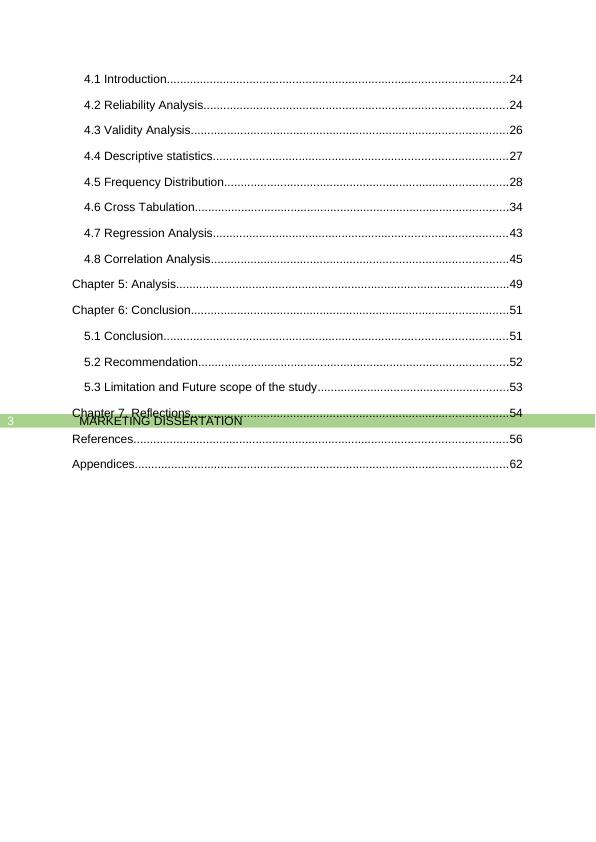
MARKETING DISSERTATION4
Topic: Investigating the attitude of the Nepali consumer towards organic food
products in Denmark
Chapter 1: Introduction
1.0 Introduction
The organic food industry has witnessed remarkable growth due to the rapid
change in consumer behaviour of the population all over the world. In the last
decade, media has also provided significant attention to the benefits of the organic
food industry (Eckert, 2018). Globalisation has widened the horizon of the industry
and has even reached the countries in the Asian continent (Eckert, 2018).
Furthermore, sustainability in agriculture has also influenced the promotion of the
organic food industry for mitigating the adverse effects of traditional agricultural
methods (Thøgersen et al., 2017). The advancement of technology in the past few
years due to globalisation has resulted in the development of low-input seasonal
crops. Denmark has experienced the highest growth in the global market, but the
analysis of past literary sources show a lack of literature on the attitude of Nepali
consumers in Denmark on organic food products (Kaad-Hansen, 2019). Denmark
has experienced a significant increase in the Nepalese population in the past few
years and the popularity of organic food industry has been rising in Nepal. Therefore,
it makes it appealing to understand the way these consumers perceive organic food
products in Denmark. Moreover, targeting these consumers could increase the sales
volumes of the organic food companies in Denmark but it depends on their attitude
and perception
1.1 Background of the study
The evaluation of market data on the organic food industry in Denmark has
seen a high level of acceptance from the consumers (Kaad-Hansen, 2019). Organic
sales in Denmark have set records in the year of 2018, which increased the growth
of the organic food industry by 14% in a year (Kaad-Hansen, 2019). Moreover, it
was seen that more than 50% of the Danes are purchasing organic food at least
once a week. The government certified, and unique Ø-label has significantly
contributed to the massive growth of the organic food industry in Denmark (Kaad-
Hansen, 2019). The figure 1 below shows that market share of the organic food
industry in Denmark in the past few years which shows significant growth in the
Topic: Investigating the attitude of the Nepali consumer towards organic food
products in Denmark
Chapter 1: Introduction
1.0 Introduction
The organic food industry has witnessed remarkable growth due to the rapid
change in consumer behaviour of the population all over the world. In the last
decade, media has also provided significant attention to the benefits of the organic
food industry (Eckert, 2018). Globalisation has widened the horizon of the industry
and has even reached the countries in the Asian continent (Eckert, 2018).
Furthermore, sustainability in agriculture has also influenced the promotion of the
organic food industry for mitigating the adverse effects of traditional agricultural
methods (Thøgersen et al., 2017). The advancement of technology in the past few
years due to globalisation has resulted in the development of low-input seasonal
crops. Denmark has experienced the highest growth in the global market, but the
analysis of past literary sources show a lack of literature on the attitude of Nepali
consumers in Denmark on organic food products (Kaad-Hansen, 2019). Denmark
has experienced a significant increase in the Nepalese population in the past few
years and the popularity of organic food industry has been rising in Nepal. Therefore,
it makes it appealing to understand the way these consumers perceive organic food
products in Denmark. Moreover, targeting these consumers could increase the sales
volumes of the organic food companies in Denmark but it depends on their attitude
and perception
1.1 Background of the study
The evaluation of market data on the organic food industry in Denmark has
seen a high level of acceptance from the consumers (Kaad-Hansen, 2019). Organic
sales in Denmark have set records in the year of 2018, which increased the growth
of the organic food industry by 14% in a year (Kaad-Hansen, 2019). Moreover, it
was seen that more than 50% of the Danes are purchasing organic food at least
once a week. The government certified, and unique Ø-label has significantly
contributed to the massive growth of the organic food industry in Denmark (Kaad-
Hansen, 2019). The figure 1 below shows that market share of the organic food
industry in Denmark in the past few years which shows significant growth in the
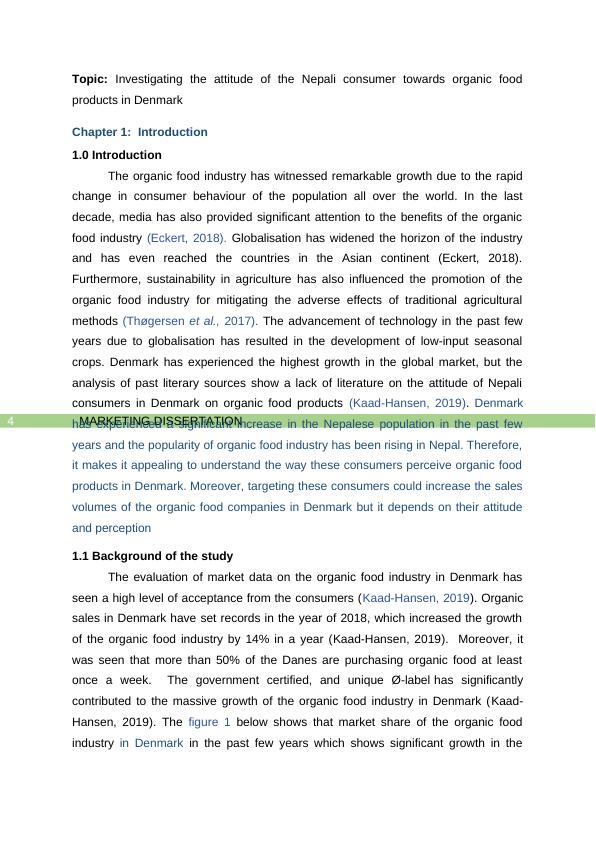
MARKETING DISSERTATION5
products sold. It can be seen in figure 2 that fruits and vegetables contribute to one
third of the total organic sales in the retail sector. It means that fruits and vegetables
are the broadest product category in the organic segment (Kaad-Hansen, 2019). The
dairy sector is the segment with the second-largest sales in the organic industry
(Kaad-Hansen, 2019). However, the booming growth of the organic food industry
has been experienced due to the retail and online sector.
Moreover, the export segment in the organic food industry has been growing
significantly, and there is a noteworthy increase in demand of Danish organic food
products. In the year of 2017, Denmark exported organic food products amounting to
DKK 2951 and Germany is the largest target market for these Danish products. It
contributes to 42% of the total export volumes (Kaad-Hansen, 2019). Other
prominent countries where organic products are being exported comprises of
Sweden, France and China. The dairy food industry is the most prominent exported
products and the increase in appetite for Danish organic food products. The exports
in the industry have doubled within just four years due to the high standards of food
quality, safety and a unique system of control.
Figure 1: Organic food market share
Source: (Kaad-Hansen 2019)
products sold. It can be seen in figure 2 that fruits and vegetables contribute to one
third of the total organic sales in the retail sector. It means that fruits and vegetables
are the broadest product category in the organic segment (Kaad-Hansen, 2019). The
dairy sector is the segment with the second-largest sales in the organic industry
(Kaad-Hansen, 2019). However, the booming growth of the organic food industry
has been experienced due to the retail and online sector.
Moreover, the export segment in the organic food industry has been growing
significantly, and there is a noteworthy increase in demand of Danish organic food
products. In the year of 2017, Denmark exported organic food products amounting to
DKK 2951 and Germany is the largest target market for these Danish products. It
contributes to 42% of the total export volumes (Kaad-Hansen, 2019). Other
prominent countries where organic products are being exported comprises of
Sweden, France and China. The dairy food industry is the most prominent exported
products and the increase in appetite for Danish organic food products. The exports
in the industry have doubled within just four years due to the high standards of food
quality, safety and a unique system of control.
Figure 1: Organic food market share
Source: (Kaad-Hansen 2019)
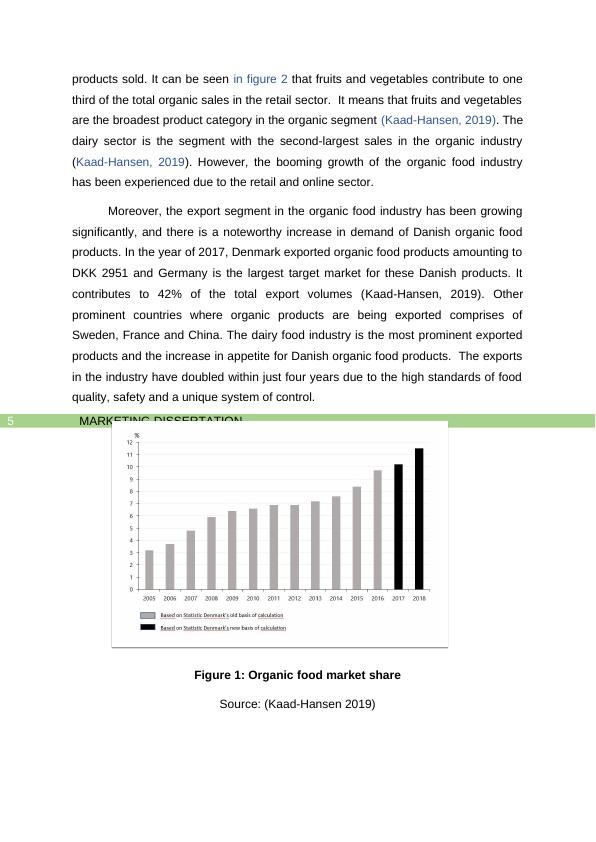
MARKETING DISSERTATION6
Figure 2: Organic food turnover per category
Source: (Kaad-Hansen 2019)
Figure 3: Organic food growth
Source: (Kaad-Hansen, 2019)
The above data has provided a highlight of the organic food industry in
Denmark. However, it has not talked about the response from different ethnic groups
on the purchase of organic food products. Therefore, it invoked the need to evaluate
Figure 2: Organic food turnover per category
Source: (Kaad-Hansen 2019)
Figure 3: Organic food growth
Source: (Kaad-Hansen, 2019)
The above data has provided a highlight of the organic food industry in
Denmark. However, it has not talked about the response from different ethnic groups
on the purchase of organic food products. Therefore, it invoked the need to evaluate

MARKETING DISSERTATION7
past studies to understand the arguments and contradictions presented by diverse
authors. The analysis of the past literary sources concerning the ethnicity of the
consumers has shown different behaviour and attitude towards organic food
products (Eckert, 2018). The different ethnic groups belonging to different socio-
demographic factors are found to be significant in their preferences for organic food
products. However, there is a lack of literature on the attitude of Nepali consumers
and their preferences towards the organic food industry. It implies that ethnicity has
not been considered as a factor affecting the attitude of the consumers in the market.
1.2 Research problem
In context to the past literary sources, it can be seen that there has been
significant growth in the demand for organic food products in the global market. Past
literature shows that in various cases, logit functions and models has been
performed. It provides an understanding of how the different demographic and social
factors affect the attitude of the consumers towards organic food products. The
analysis of the past research shows that changes in the socio-economic background
of the global population have made the consumers more affluent and educated,
which has increased the awareness of the consumers towards a healthy lifestyle.
This change in lifestyle has affected the food choices of various ranges of
consumers, but the factors affecting their purchase behaviour and attitude towards
the products differ. The different literature has examined the attitude of the Chinese,
Malay, Swedish, German, Indian and other ethnic backgrounds (Loebnitz and
Aschemann-Witzel, 2016). However, there is a lack of study on the attitude of Nepali
consumers. Therefore, little is known about their attitude of the consumers based on
ethnicity in Denmark. Even though there is evidence stating the increase in
awareness and demand for organic food products in Nepal, but it is not sufficient to
differentiate between the different ethnic groups. The analysis of the Nepalese
population shows that the number of consumers can be considered to be only 1% of
the total population in Denmark (Shah, 2016). However, it is essential to measure
the attitude of these consumers to establish a trade relationship with Nepal and
improve export volumes.
1.3 Research objectives
The research has examined the attitude of Nepali consumers towards organic
food products in Denmark. In general, Denmark has the highest level of acceptance
past studies to understand the arguments and contradictions presented by diverse
authors. The analysis of the past literary sources concerning the ethnicity of the
consumers has shown different behaviour and attitude towards organic food
products (Eckert, 2018). The different ethnic groups belonging to different socio-
demographic factors are found to be significant in their preferences for organic food
products. However, there is a lack of literature on the attitude of Nepali consumers
and their preferences towards the organic food industry. It implies that ethnicity has
not been considered as a factor affecting the attitude of the consumers in the market.
1.2 Research problem
In context to the past literary sources, it can be seen that there has been
significant growth in the demand for organic food products in the global market. Past
literature shows that in various cases, logit functions and models has been
performed. It provides an understanding of how the different demographic and social
factors affect the attitude of the consumers towards organic food products. The
analysis of the past research shows that changes in the socio-economic background
of the global population have made the consumers more affluent and educated,
which has increased the awareness of the consumers towards a healthy lifestyle.
This change in lifestyle has affected the food choices of various ranges of
consumers, but the factors affecting their purchase behaviour and attitude towards
the products differ. The different literature has examined the attitude of the Chinese,
Malay, Swedish, German, Indian and other ethnic backgrounds (Loebnitz and
Aschemann-Witzel, 2016). However, there is a lack of study on the attitude of Nepali
consumers. Therefore, little is known about their attitude of the consumers based on
ethnicity in Denmark. Even though there is evidence stating the increase in
awareness and demand for organic food products in Nepal, but it is not sufficient to
differentiate between the different ethnic groups. The analysis of the Nepalese
population shows that the number of consumers can be considered to be only 1% of
the total population in Denmark (Shah, 2016). However, it is essential to measure
the attitude of these consumers to establish a trade relationship with Nepal and
improve export volumes.
1.3 Research objectives
The research has examined the attitude of Nepali consumers towards organic
food products in Denmark. In general, Denmark has the highest level of acceptance

End of preview
Want to access all the pages? Upload your documents or become a member.
Related Documents
The impact of effective logo design on branding and organizational profitabilitylg...
|71
|18159
|128
Assignment On Business Management Dissertationlg...
|57
|12673
|35
Impact of Globalization on Indian Business: Socially, Economically and Technicallylg...
|72
|21338
|394
Market Research about Hong Kong Online Food Delivery Serviceslg...
|75
|19796
|126
A Recommendation to all those people who have lend and helped me in carrying out the researchlg...
|62
|10725
|99
Guerrilla Marketing and its Effects on Consumer Behaviour and Brand Awarenesslg...
|105
|24470
|63
